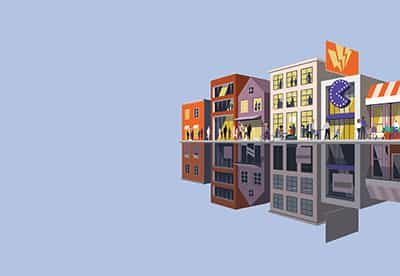
“In terms of the quality of those locations, all of these cities are now being tested for walkability. What makes a good, safe city for people to move around it, live in it, without reliance on planning, on a car. That's what's changing."
– Jo Davis, Principal and UK Executive Chair, Town Planning, Public Sector, Avison Young
In this episode
For many of us, to visit the cinema, grocery store, or the office, we must jump into a car, wait for a bus, or jostle our way onto a subway.
It’s become so routine that we might not realize there could be a much simpler alternative.
Welcome to the fifteen-minute city concept: where everything you need to live, work and play is just minutes away.
Does it sound like a dream? Too confining for your tastes?
What are the pros and cons of such a plan, and can it even exist in your city or neighborhood?
Host Mariam Sobh discusses this and more with Avison Young’s Jo Davis, UK national lead for town planning and public sector, Carlos Moreno, the professor who wrote the framework for the fifteen-minute city concept, and Nima Daivari, a Los Angeles resident who chooses to live and navigate his city car free.
Highlights
- 4:45 Jo Davis shares the evolution from industrial planning to zonal planning via planning acts and how sustainable transport’s influences needed changes.
- 6:39 Carlos Moreno shares that redefining our urban lifestyles, our commutes, and our existing relationships with downtowns could not only help us lead less hectic lives, it could help us preserve the environment and our connections with each other as well.
- 9:26 Nima Daivari talks about how cities like Los Angeles should provide mass transit systems that meet the needs and interests of the people they serve.
Click here to expand transcript
Speaker 1 [00:03] I'm coming to you from Vancouver's 10th Avenue bike path, which connects the east and west sides. Today's a sunny day, perfect for cycling, biking, taking the bus to the beach.
Speaker 2 [00:16] Yeah, there's this push around the world to create more what are called 15-minute cities. Do you think Vancouverites could benefit from having all their needs within one 15- minute radius? One neighborhood?
Speaker 3 [00:28] Yeah. I think Vancouverites could really benefit from the 15-minute city idea. Yeah, I think this is something that we've talked about a bit in school. I'm studying landscape architecture, and that's something that's really emphasized.
Speaker 4 [00:43] I used to live down in Marpool and it was a nice community, but it was not quite as convenient. But living in this area, I just think of the time I save just having everything local, as opposed to trying to travel everywhere and get things. So yeah, absolutely. I'm all about that.
Mariam Sobh [00:58] Imagine you live in a city where, to go to the grocery store which is closest to your house, you have to get in your car and drive there because the walk would take 45 minutes versus a 10 mi-nute car ride. This is a reality for millions of people around the world. Sometimes you have to travel across the city just to find a specialty store, go to a museum, or in a lot of pre- pandemic cases, traverse the entire city just to go to work, five days a week, for the rest of your working career. Now, what if I told you that there was a movement underway that would bring your job, ameni-ties, and social activities within no more than a 15- minute bike ride or walk from your front door? The future is here, and it's coming to life in Paris. The 15- minute city is taking the world by storm. From Paris to Bologna, Madrid to Bogota, the cities we've known are becoming a thing of the past. And quite frankly, why not? According to Move It, the average person spends two hours on public transportation to get to and from work in Paris. Meantime, Forbes notes that Par-is intends on removing 60, 000 private car parking spaces by 2024, as part of Mayor Anne Hi-dalgo's effort to create self- sufficient communities within one of Europe's oldest cities. However, Bloomberg warns that European cities may be better suited for this model rather than the vast sprawling metropolises of North America. So if we look into the past to understand why our urban landscapes, the cities we call home, are the way they are, then we can begin to implement changes to make them more accessible by foot or bike. However, change never comes quickly, but sometimes it happens faster than anyone ever realized. I'm Mariam Sobh. In this episode of Changing Places, we're going to explore the world of 15- minute cities with Jo Davis, an expert with over 25 years experience on complex urban change projects for public and private sector clients from Avison Young, as well as thoughts from Professor Carlos Moreno, the man on the forefront of this shift in how we live, work, and play. And insight into what a 15- minute city would mean to a committed carless citizen, attorney Nima Daivari from Los Angeles.
Nima Daivari [03:22] My name is Nima Daivari. I'm an attorney. I live in East Hollywood and I'm a LA Metro public transit rider. It is a lifestyle choice that I've made to not have a car and try to navigate this city with the public transit systems that we have. It is limiting in that there are specific places that are easy to get to, and then certain places that are almost impossible to get to unless you have un-limited time. I don't think spending two hours to go five miles is a reasonable amount of time to spend in transit.
Mariam Sobh [03:56] That was Nima Daivari giving us some insight into the challenges of navigating Los Angeles with-out the use of a car. I'm Mariam Sobh. Welcome back to Changing Places. In order to under-stand how we got here, I'm going to chat with Jo Davis, who has over 25 years' experience on complex urban change projects for public and private sector clients. I'm going to take a deep di-ve with her into the world of 15- minute cities in the United Kingdom to see who is doing it right and what it means for the future of work, play, and society within our ever- evolving world. Jo Davis, welcome to Changing Places. Jo, how did we get to a place in our world where most of what we need and do is located so far from our homes or immediate neighborhoods?
Jo Davis [04:41] I think you've got to look really back quite a long way to get to that answer. The industrial revolu-tion was fundamental in all of that, and then that moved through the 19th and 20th century with zonal planning. So in effect, what we did is we put homes in one location, and we zoned the em-ployment in another location, and the shops in the other. And of course then, with the growth of the car, that was absolutely fine. So, that's how we got to zonal planning. What obviously has changed in the UK is that that was based on a 1947 planning act. But we then turned around to the 1990 planning act, it was all about sustainable transport. It was actually all about actually, what does sustainable city mean? And therefore, we had to question whether actually those bar-riers to connecting places was failing us.
Mariam Sobh [05:27] Yeah. In some cities like London, the theater district is in the West End, and more niche high streets like those in Kensington and Hampstead are located on the other side of the city. Is the urban plan of our current cities restrictive by design, or just by folks buying into this idea that this is how things are, and this is just how it will continue to be?
Jo Davis [05:49] Well, it's really interesting. The starting point is that still, 80% of our population has a car. So im-mediately this first thought is to go by car or to travel by car. So that connection is done by car in the first instance. Second point that you just raised, which I think is largely important, more so in the UK than possibly elsewhere globally, is the fact that actually the history of how our cities has evolved influences where things are located, but also how you travel around places. And that's been really important, therefore, in actually allowing us to redress this point and to actually chal-lenge whether traveling to leisure and traveling to shops by car is the only option. And those bar-riers are being broken down there.
Mariam Sobh [06:35] Let's hear from Professor Carlos Moreno, the man at the forefront of the 15- minute city.
Carlos Moreno [06:40] We need today to redefine our urban lifestyle, because this urban alternative lifestyles are not sustainable. One of the most relevant contribution is our crazy commute for going from my home to our office, two, three hours for a round trip. And at the same time, all actions linked with this hectic urban alternative lifestyles, we need to change not only preserving our environment, but for preserving our social link.
Mariam Sobh [07:23] Prior to Mayor Anne Hidalgo's commitment to making Paris a 15- minute city, there were places like cities... Amsterdam prided themselves on being very accessible, but was that simply be-cause of the size of the city, or was that planned out? And are you seeing anything similar to that in the UK?
Jo Davis [07:40] So I think without question that your Paris and your Amsterdams, they were planned out. That approach was in policy. That 15- minute walking place was in policy. Whilst it's best practice in the UK, in terms of the time and country planning association in the Royal Time Planning Institute, it's not policy, it's not dictated. So therefore our ability is influenced by that. But then what's really happened in the UK, which I think is really interesting is that we started to challenge what makes a good place. And instead of designing for the car or designing for specific locations, what would you think is not what it looks like on the outside. How does it function? How does that space function? How do people move through it? In the city centers, what do people need to have a successful lifestyle? So actually therefore moving away from the need from a car into actually I need a really good cycle route, or I really need a really good place to sit outside to enjoy my envi-ronment. And certainly COVID in the UK fundamentally changed that when everybody flipped from eating inside to outside. So therefore those spaces, that road space and the quality and the air quality of those spaces to allow people to sit outside fundamentally flipped overnight. And that's really changed, not through policy and dictate, but actually through people's demands and wants and expectations of the city. That's what's really started to change and that's what makes it really interesting in terms of the way we move forward now.
Mariam Sobh [09:05] Stay tuned for the next part. And, just a reminder, Changing Places is a podcast brought to you by Avison Young that continues to explore and question our complex relationship with the built world around us. I'm your host, Miriam Sobh. I hope you're liking the show so far. If so, please share Changing Places with your friends.
Nima Daivari [09:26] I do. I do think we are quite a ways away from having pockets of 15-minute cities where you can walk or bike everywhere. I think if you add rail and bus to that definition, it becomes a little bit more feasible. I think actually east Hollywood as a sub neighborhood of Hollywood is a great place. Unfortunately, there are a lot of people who, through circumstance, must spend four hours commuting two hours each way due to income restrictions, education restrictions, or whatever it is that has them doing that. But that's not great. Cities are supposed to provide a service. The mass transit systems are not for- profit systems. They are government services in order to help people move through the cit-ies. When it's not built right, when you have to spend four hours doing it because you have no other option, that's not really feasible. And more people will not adopt using alternative modes of transportation when they have to wait a long time.
Mariam Sobh [10:24] Welcome back to Changing Places. We just heard from Nima Daivari. But before we get back to my conversation with Jo Davis, who has over 25 years experience on complex urban change projects, let's go back to Vancouver to hear what folks think about 15-minute cities in their com-munity.
Speaker 9 [10:42] I don't know that Vancouver would benefit from having it broken up into small units of walkability. That kind of tends to lead to exclusivity. But I am all for walking and biking to get where you need to go to. I have a car, but I rarely, if ever, drive it. So it means a lot to me to be able to live in a neighborhood where I can get to where I need to get to on foot or by bike. But I would be appre-hensive about, like right now, I'm walking from one neighborhood to a very different neighborhood and I wouldn't like to see myself limited to just that 15-minute walk, just out of interest and curiosi-ty and expansiveness of a cultural experience. One neighborhood is not going to have every-thing I need. I'm not a big fan of having everything I need in just one 15 minute walk. Although I do understand that that's very helpful and useful to some people.
Mariam Sobh [11:35] When it comes to the UK, are there cities that are committing to becoming 15 minute cities? And on the flip side of that, are there cities that are just dropping the ball?
Jo Davis [11:47] Not necessarily 15-minute cities in the way that you are perceiving them in your kind of your Par-is and your Amsterdam where there's a dictate to that. In terms of the quality of those locations, all of the cities attest about walkability. What makes a good, safe city for people to move around it, live in it without reliance on the planet or on the car? That's what's changing. So in effect it's a parallel process to 15-minute cities, but it's being taken from a different angle.
Speaker 10 [12:13] I can't speak for all Vancouverites but it's definitely something that appeals to me. Yeah, and that's just because I decided many years ago to go car free. And that's as a result of living in Ja-pan for a year and relying on mass transit. Tokyo was highly transited. There were trains and transit everywhere to go everywhere and was so convenient. So I came back to Vancouver and I just wanted to see if I could live that lifestyle here. And I'm very pro 15-minute cities.
Mariam Sobh [12:53] Can you tell me about how and why Bristol, England, from your point of view, has adopted a 15 minute city ethos and how it will benefit the city and its residents in the long term?
Jo Davis [13:03] So I think Bristol is ahead of the game. So when it had its cycle strategy in 2000, so it was the European cycle city, that changed the goalpost into the way that people were intended or en-couraged to move around the city. So we started to create the Brunel Mile that went from the train station right away to the city center and into the residential areas. That created the opportu-nities and the space for people to walk and cycle safely across the city. We're seeing policies that require every development on the Harbor side to have a Harbor side walk in front of it so you can do a circular walk around it. So there's a number of really good policies that have been put forward by the city, through its planning process to blend that kind of 15 minute city center and that removal of cars from the city. So it's a carrot and stick approach.
Mariam Sobh [13:52] Again, professor Carlos Moreno.
Carlos Moreno [13:55] Seattle is totally committed in this way of a more compact city, more mid city for offering more and more intersections between the functional services mid city for having a more social inter-sections.
Mariam Sobh [14:15] Jo, how does a 15 minute city work for young families who have kids?
Jo Davis [14:21] I think there you hit one of the biggest challenges that we've got at the moment. So the city cen-ter lifestyle that we're talking about, that high rise apartments, that no need for a car is very much at the moment the younger person's, the single person, the young couples, the professional couples kind of safe space. And I think that what we need to look at really carefully moving for-ward is actually how do we keep our families in the UK and our city centers very much like we see across the water in Chicago. It's quite common there. So that then becomes about quality spaces. So actually, what does a quality park look like? How do we ensure that within our cities, those things are within a 15-minute walkable distance? That the schools within a 15 minute walk-able distance? This does come back to the air quality as well. If you've got the air quality and you've got safe parks and you've got good spaces within your cities, then people will stay in there. But ultimately that is the flows that the UK needs to address is actually that movement out to a house in suburbia and then that need to travel is where it comes back around to that piece about that 15-minute neighborhood, and actually around that school where you are living. Can you walk to all of the things you need to within that part of your suburb or within that part of your development? And historically right up until the eighties early nineties, the UK was just designing housing estates. It wasn't designing mixed uses on the edges of our city center. That's funda-mentally changed when we're putting mixed uses in there. So there is employment, there is rec-reation.
Mariam Sobh [15:55] It's interesting learning about these 15-minute cities because where I live, I'm in Chicago, and everything is walking distance. And every time we think about moving, I'm just like the kid's school is here, the grocery stores here, the library, we work from home. Do we really want to move somewhere where we have to drive to the grocery store?
Jo Davis [16:12] It's definitely changing. And therefore, what you've also seen of course is that the grocery store is changing. We lived in a 30 year decade of out of town retail stores, largely of car parking. That's changing. In London, we are redeveloping those sites. Still having a retail store, but having residential above it and residential within the car park because actually people's mindsets are changing. And I think that's only going to accelerate.
Mariam Sobh [16:37] How feasible would it be to take that and replicate a 15 minute city into a larger city like London, which is quite fast.
Jo Davis [16:46] I think in terms of London, in terms of our bigger accommodations like Birmingham and Man-chester, you do it in zones. So there are quarters within the city and that 15-minute walk around is around say a quarter or a neighborhood. And again, that's really, really increased in popularity and strength due to COVID because people actually were working at home and therefore were then starting to rely on their neighborhood facilities. And most of those neighborhood facilities were really good. But again, you've still got 4% of the country traveling one mile. So getting in a car to travel just one mile, which is such a walkable distance. So there's still a mindset to go. The other policy piece, which is really important, new developments where they're focused around our public transport networks, they don't have any cars. So kind of you have car free develop-ments now in our cities because they have good public transport and they have good cycle facili-ties for parking. So those sorts of measures allow you to start making those changes. But I think in terms of our bigger metropolitan areas, it's very much about those 15 minutes neighborhoods rather than a 15-minute city per se.
Mariam Sobh [17:53] Let's hear from Nima Daivari in Los Angeles.
Nima Daivari [17:57] Despite my criticisms of the LA Metro system, I am opting into the system. I could purchase a car if I wanted to, but I really believe in mass transit. I really believe in reducing my carbon foot-print, our collective carbon footprint. And so I would really like to see the system succeed. And it is one of those things, if you build it, they will come. But you need the funding in order to build it. And if they're not coming, then you don't have the funding. So it's a real chicken egg situation. One of the great things about being a public transit rider for the company that I work for is that by forgoing my parking space, they then subsidize my Metro pass. So my travel costs are literally $ 0 outside of the occasional ride share or other mode I might use. I do rent a car sometimes if I need to do X, Y, or Z, but yeah, I ride around the city completely free simply because I gave up one parking space to a major employer. And I'm very grateful for that.
Mariam Sobh [18:53] Is the idea of 15-minute city then, only adaptable to established cities that have this sort of infra-structure already in place? Or is there potential to redevelop or change things in these very car specific types of areas?
Jo Davis [19:12] I think without question, everything's adaptable. So some of those principles will work in some cities and not in others. In Bristol we're seeing subways coming up to ground to improve the safety of people moving around them. So there's lots and lots of measures that can be done. And I think it's a bit of a best practice piece here. And I think that our city leaders across the UK are constantly talking about these things. We at Avison Young are constantly sharing our knowledge and our best practice from certain cities into our revenue regeneration strategy. So there's a whole learning curve continually moving forward. But I think there is a time there where it's not unreasonable to expect that the car won't be the predominant movement in the city center. And actually we will see those car space, when we're so short of land, that those streets will actually be reduced in size and they will become development parks. It's a really exciting time.
Mariam Sobh [20:08] Jo, I'm curious, as we look forward, what does the future hold in store for 15-minute cities, the governments which run them and the people who live within them? Let's dive into that in a mo-ment. But first more insight from professor Carlos Moreno.
Carlos Moreno [20:24] We need to give to the reality to streets, to square, to places, to neighborhood, human environ-mental liability because the neighborhood are necessary for hosting this humanity. And our cities today, unfortunately, I think that we have built big metropolis', big cities without considering the importance of living humanity.
Speaker 11 [21:03] I mean, it's a good idea. The citizens of Vancouver have all their needs met within 15 minutes where they live. I'm like, well, what are all the needs? If I have a need to go swimming in the ocean, how are you going to do that within 15-minutes of where I live? I mean, you can have a bathroom, you can have a place to eat, you can have a place to work. I don't know. Is that the limit of our needs? I don't think so. I think it's a good idea. I don't know. You could meet every-body's needs.
Mariam Sobh [21:34] If we look ahead Jo, to the next five years or so, where do you think we'll be when it comes to 15-minute cities around the world?
Jo Davis [21:41] The critical things I think we are going to see is we're going to see a significant intensification of development around our public transport hubs. So some of the work that we've done in London on Crossrail is actually what is the value of going high and tall and dense development around a new station because that's sustainable. And that's the accessibility piece that people want to. I think without question, we'll be seeing that. I think we're already seeing gentrification into our his-toric industrial areas. So therefore we are already then allowing that opportunity for greater walk-ing cities because, where we've had core industrial areas within our city centers from just a his-toric piece, they're being redeveloped and that's therefore allowing those connections to come in place. But also the really important pieces, 20 years ago, every development we had had two car parking spaces. Move on now, very few car parking spaces in any of our developments. Look-ing forward, it won't even be a conversation. So the process of development is changing. And also there's a commerciality here. That it's not needed, people aren't having one car. Car show is a much stronger thing. And that connection and that safety around the city is being considered far more important. The next thing will be the redevelopment of multi-story car parks for housing. It's on its way.
Mariam Sobh [22:58] Well, I want to thank you so much for joining us, Jo Davis.
Jo Davis [23:01] Pleasure.
Mariam Sobh [23:03] I'd like to thank Jo Davis, professor Carlos Moreno and Nima Daivari for taking time to give us insight into the world of 15-minute cities. Before we go, let's hear more from professor Moreno one last time.
Carlos Moreno [23:17] I am humble because I consider that this 15-minutes concept, this is not naive 15-minute con-cept. I am the initiator. I am the creator. But at the same time, we needed to launch an idea and we needed that this idea will become a autonomous idea for different cultural, social, economical concept for being one framework for transforming our urban life. Even if the impact of our trans-forming our urban life is the 10% to 5%, 2% of my initial idea. This is enough for behind.
Mariam Sobh [24:05] I think the possibility of living in a city where everything is within a 15-minute walk or bike ride is really exciting. For so long, we as citizens of the world and our neighborhoods have driven or commuted for over an hour just to go to an appointment or decent grocery store. And with gas prices going up, the trip has been made even less appealing. The mere idea of every city having neighborhoods which cater to their residents with social infrastructure, amenities, entertainment, and even co- working spaces to allow people not just to work from home, but down the street from their house is a concept which could change the world. Change doesn't happen overnight, but maybe, just maybe the spark of the 15-minute city will ignite into a global demand for choice, options and above all more say into the immediate built world around us. I'm Mairiam Sobh. This is Changing Places. Join us for our next episode, as we explore the world of planned communi-ties. From Celebration, Florida to Prince Charles's Poundbury in the UK, we're going to take a deep dive into this unique part of the built world and see why it has so many fans, detractors and what it means for your community. Changing Places is brought to you by Avison Young. Our producer is Andrew Pemberton Fowler. Our sound engineer is Patrick Emile. Our producer as-sistant is Hugh Perkic. Additional production support is provided by JAR Audio.
Subscribe to receive Avison Young podcast updates
Related episodes from Avison Young podcast
-
 Made to serve: The rise and future of robot restaurantsOctober 31, 2022
Made to serve: The rise and future of robot restaurantsOctober 31, 2022 -
 From fashion to axe throwing: How the high street continues to evolveOctober 24, 2022
From fashion to axe throwing: How the high street continues to evolveOctober 24, 2022 -
 The vitality of the city: Data and patterns in the new era of downtownOctober 17, 2022
The vitality of the city: Data and patterns in the new era of downtownOctober 17, 2022 -
 Through the looking glass: Into the emerging world of the metaverseSeptember 19, 2022
Through the looking glass: Into the emerging world of the metaverseSeptember 19, 2022




